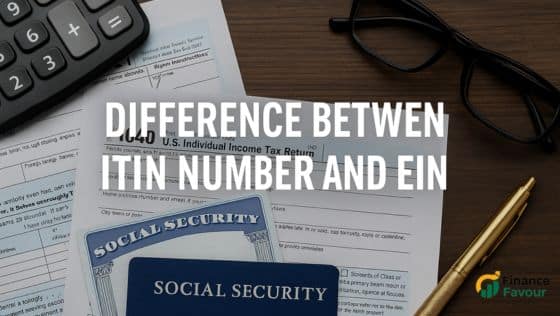Navigating the complexities of tax identification in the United States can often be challenging, especially for foreign investors and individuals venturing into the realm of U.S. real estate. Understanding the difference between an ITIN (Individual Taxpayer Identification Number) and an EIN (Employer Identification Number) is crucial for anyone engaging in financial activities within the country. Both numbers serve distinct purposes and are essential for tax obligations, yet they cater to different needs and entities. In this guide, we will break down the key aspects of these tax identification numbers, providing you with the knowledge needed to make informed financial decisions. Join us as we delve into the specifics of how to apply for an ITIN and EIN, ensuring you are well-prepared to manage your investments effectively.
Understanding Tax Identification Numbers
Tax identification numbers are crucial for financial activities in the United States. Let’s explore the two main types: ITIN and EIN, and understand their importance.
What is an ITIN?
An Individual Taxpayer Identification Number (ITIN) is a tax processing number issued by the Internal Revenue Service (IRS) for individuals who are required to have a U.S. taxpayer identification number but are not eligible for a Social Security Number (SSN).
ITINs are primarily used by foreign nationals and non-resident aliens who have tax filing obligations in the United States. This includes individuals who earn income from U.S. sources, such as investments or rental properties.
The ITIN is a nine-digit number that always begins with the number 9 and has a format similar to an SSN (XXX-XX-XXXX). It’s important to note that an ITIN does not provide work authorization or eligibility for Social Security benefits.
What is an EIN?
An Employer Identification Number (EIN), also known as a Federal Employer Identification Number (FEIN), is a unique nine-digit number assigned by the IRS to business entities operating in the United States.
EINs are used to identify businesses for tax purposes, similar to how Social Security Numbers identify individuals. They are essential for various business activities, including opening bank accounts, applying for business licenses, and filing tax returns.
Unlike ITINs, EINs are not limited to foreign entities. Any business operating in the U.S., regardless of ownership nationality, may need an EIN for tax reporting and other legal requirements.
Importance of Tax Identification Numbers
Tax identification numbers play a crucial role in the U.S. financial system, enabling individuals and businesses to comply with tax laws and engage in various financial activities.
For individuals, an ITIN allows those without SSNs to fulfill their tax obligations, open interest-bearing bank accounts, and in some cases, claim tax treaty benefits. It’s a vital tool for foreign investors in U.S. real estate.
For businesses, an EIN is essential for tax reporting, hiring employees, and establishing credibility with financial institutions. It’s a fundamental requirement for most business operations in the United States.
Understanding these numbers is crucial for anyone involved in U.S. financial activities, especially foreign investors and business owners.
Key Differences Between ITIN and EIN
While both ITINs and EINs are tax identification numbers, they serve different purposes and have distinct eligibility criteria. Let’s explore these differences in detail.
Purpose and Usage
ITINs and EINs serve different purposes in the U.S. tax system and are used in distinct contexts.
ITIN Purpose and Usage:
- Used by individuals who need to file U.S. tax returns but are not eligible for SSNs
- Allows foreign investors to open interest-bearing bank accounts
- Enables claiming of certain tax treaty benefits
- Used for reporting income from U.S. sources, including rental income from real estate
EIN Purpose and Usage:
- Identifies business entities for tax purposes
- Required for hiring employees and payroll processing
- Necessary for opening business bank accounts
- Used for filing business tax returns and other IRS documents
While both numbers facilitate tax reporting, ITINs are for individual use, whereas EINs are primarily for business entities.
Eligibility Requirements
The eligibility criteria for ITINs and EINs differ significantly, reflecting their distinct purposes.
ITIN Eligibility:
- Non-resident aliens required to file U.S. tax returns
- U.S. resident aliens (based on days present in the U.S.) filing U.S. tax returns
- Dependents or spouses of U.S. citizens/resident aliens
- Foreign individuals with U.S. source income
EIN Eligibility:
- Any business entity operating in the U.S.
- Corporations, partnerships, and limited liability companies
- Sole proprietors with employees or those filing certain tax returns
- Estates and trusts
It’s important to note that while individuals typically need either an SSN or an ITIN, businesses may need both an EIN and the owner’s personal tax identification number (SSN or ITIN).
Difference Between ITIN Number and EIN Table
Here’s a clear comparison table showing the difference between an ITIN (Individual Taxpayer Identification Number) and an EIN (Employer Identification Number):
| Feature | ITIN (Individual Taxpayer Identification Number) | EIN (Employer Identification Number) |
|---|---|---|
| Purpose | For tax reporting by individuals not eligible for a Social Security Number | For identifying a business entity for tax and legal purposes |
| Issued By | Internal Revenue Service (IRS) | Internal Revenue Service (IRS) |
| Format | 9-digit number starting with 9 (e.g., 9XX-XX-XXXX) | 9-digit number with format XX-XXXXXXX |
| Who Uses It | Non-resident aliens, foreign nationals, dependents/spouses of U.S. citizens | Business entities, LLCs, corporations, sole proprietors |
| Used For | Filing U.S. tax returns, opening bank accounts, receiving refunds | Hiring employees, opening business bank accounts, tax reporting |
| Eligibility | Individuals not eligible for a Social Security Number | U.S. and foreign entities doing business in the U.S. |
| Used By Foreign Nationals? | Yes | Yes |
| Employment Use | No – not valid for work authorization | Yes – used by employers to report wages and withholdings |
| Tax Filing Use | Yes – required for filing individual tax returns | Yes – required for filing business tax returns |
How to Apply for ITIN and EIN
Obtaining the correct tax identification number is crucial for compliance and financial activities in the U.S. Let’s walk through the application processes for both ITINs and EINs.
Step-by-Step ITIN Application
Applying for an ITIN involves several steps and requires careful attention to detail. Here’s a simplified guide:
- Determine if you need an ITIN by reviewing IRS guidelines.
- Gather necessary documents: a completed Form W-7, valid tax return, and proof of identity and foreign status.
- Submit your application package to the IRS, either by mail or in person at an IRS office or through an authorized Acceptance Agent.
The processing time for ITIN applications can take up to 7 weeks during peak tax season. It’s advisable to apply well in advance of any tax filing deadlines.
Remember, ITINs expire if not used on a federal tax return for three consecutive years. Be sure to renew if necessary to avoid delays in future tax processing.
Step-by-Step EIN Application
The EIN application process is generally more straightforward and can often be completed online. Here’s a basic outline:
- Determine your eligibility for an EIN using the IRS guidelines.
- Gather necessary information about your business, including its legal structure and the responsible party’s details.
- Apply online through the IRS website, which provides immediate issuance of your EIN.
For those unable to apply online, Form SS-4 can be submitted by mail or fax. However, these methods take longer to process.
It’s important to note that you can only obtain one EIN per day. If you’re setting up multiple businesses, plan accordingly.
Common Mistakes and How to Avoid Them
When applying for tax identification numbers, errors can lead to delays and complications. Understanding common pitfalls can help ensure a smooth application process.
Errors in Application Process
Several mistakes frequently occur during ITIN and EIN applications:
- Incomplete Forms: Ensure all required fields are filled out accurately.
- Missing Supporting Documents: For ITINs, include all necessary proof of identity and foreign status.
- Incorrect Business Classification: For EINs, accurately represent your business structure.
- Applying Unnecessarily: Confirm you actually need the number before applying.
To avoid these errors, double-check all information before submission and consult with a tax professional if you’re unsure about any aspect of the application.
Remember, accuracy is crucial. Mistakes can lead to processing delays or even rejection of your application.
Misunderstanding Requirements
Misinterpreting the requirements for ITINs and EINs is a common issue:
- Some believe ITINs provide work authorization (they don’t).
- Others think EINs are only for large corporations (sole proprietors may need them too).
- Many assume ITINs and EINs are interchangeable (they serve different purposes).
To avoid these misunderstandings:
- Thoroughly research the specific requirements for your situation.
- Consult official IRS resources or speak with a tax professional.
- Don’t rely on secondhand information or assumptions about these numbers.
Clear understanding of the requirements will help you navigate the application process more effectively and use your tax identification number correctly.
Leveraging Tax IDs for Real Estate Investment
Tax identification numbers play a crucial role in U.S. real estate investments, especially for foreign investors. Understanding how to leverage these numbers can open up significant opportunities.
Benefits for Foreign Investors
For foreign investors, obtaining the correct tax identification number offers several advantages in the U.S. real estate market:
- Compliance with Tax Laws: ITINs allow foreign investors to fulfill U.S. tax obligations on rental income and property sales.
- Access to Financial Services: With an ITIN, investors can open interest-bearing bank accounts, facilitating easier management of rental income and expenses.
- Mortgage Opportunities: Some lenders may offer mortgages to foreign investors with ITINs, expanding financing options for property purchases.
- Simplified Reporting: EINs can streamline tax reporting for real estate investments held through business entities, providing a clearer separation between personal and business finances.
By properly utilizing ITINs and EINs, foreign investors can navigate the U.S. real estate market more effectively, ensuring compliance while maximizing investment potential.
How to Apply for an ITIN or EIN as a Foreign Investor
Applying for a tax identification number as a foreign investor might seem complex, but it becomes straightforward when the process is systematically broken down. Here are the steps you’ll need to follow:
1. Determine if you need an ITIN or EIN: Research the specific requirements of your investment situation or consult with a tax professional to determine if you need to apply for an ITIN, EIN, or perhaps both.
2. Gather Necessary Documents: For ITINs, be prepared to prove both your identity and foreign status with original or certified copies of documents like your passport or national identification card. For EINs, gather all relevant business details such as legal structure, responsible party’s details, and so on.
3. Complete the Application: For the ITIN, fill out IRS Form W-7, ‘Application for IRS Individual Taxpayer Identification Number.’ If applying for an EIN, complete IRS Form SS-4, ‘Application for Employer Identification Number.’ You can do this online, by mail, or via fax, although the online method is often quickest and most convenient.
4. Submit the Application: After double-checking all details for accuracy, submit your forms along with any required supporting documents to the IRS. The specific submission method may vary depending on the form and your location.
5. Await Confirmation: After submission, you will need to wait for processing. The IRS will mail you a letter confirming your ITIN or EIN. Delays can be expected, especially during peak tax season, so consider timing your application accordingly.
6. Activate Your Number: Once you receive confirmation, your tax identification number is active and can be used for tax-related activities. Keep in mind that each number serves a specific purpose. EINs are used to identify business entities, while ITINs are used by individuals who do not have, and are not eligible to obtain, a Social Security number. Make sure to use the correct number for the correct purpose to ensure proper compliance with U.S. tax laws.
Conclusion
Understanding and obtaining the correct tax identification number – whether ITIN or EIN – can enhance foreign investors’ opportunities within the U.S. real estate market. It enables them to comply with tax laws, access necessary financial services, secure potential mortgages, and simplify tax reporting. The process may initially seem daunting, but with the right knowledge and guidance, it can be navigated successfully and efficiently.




